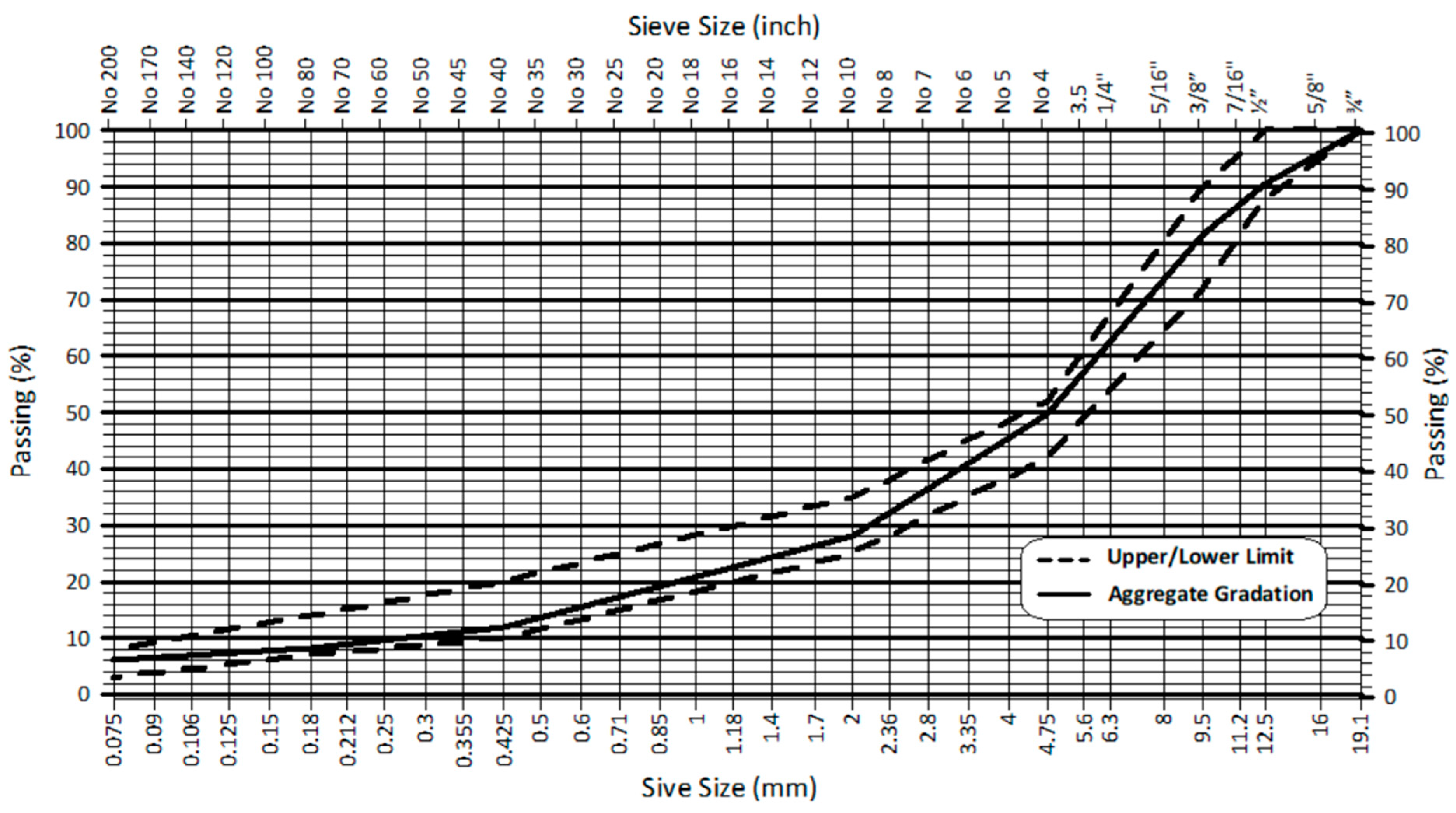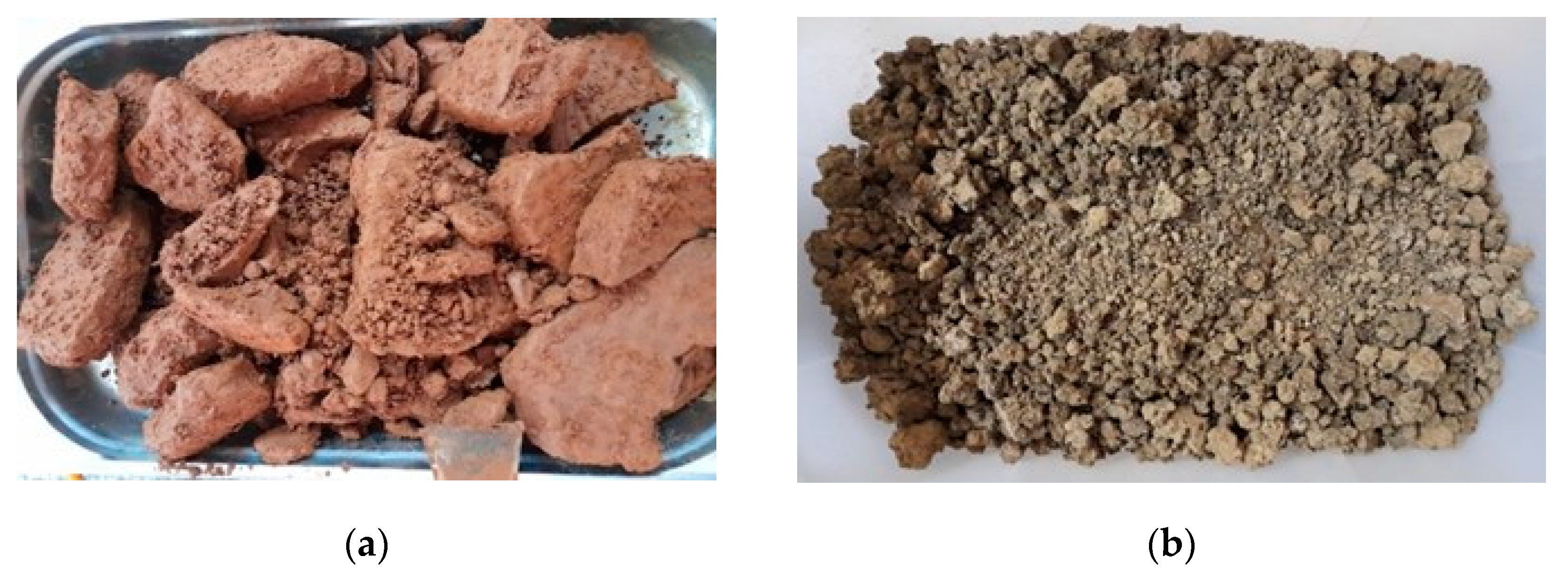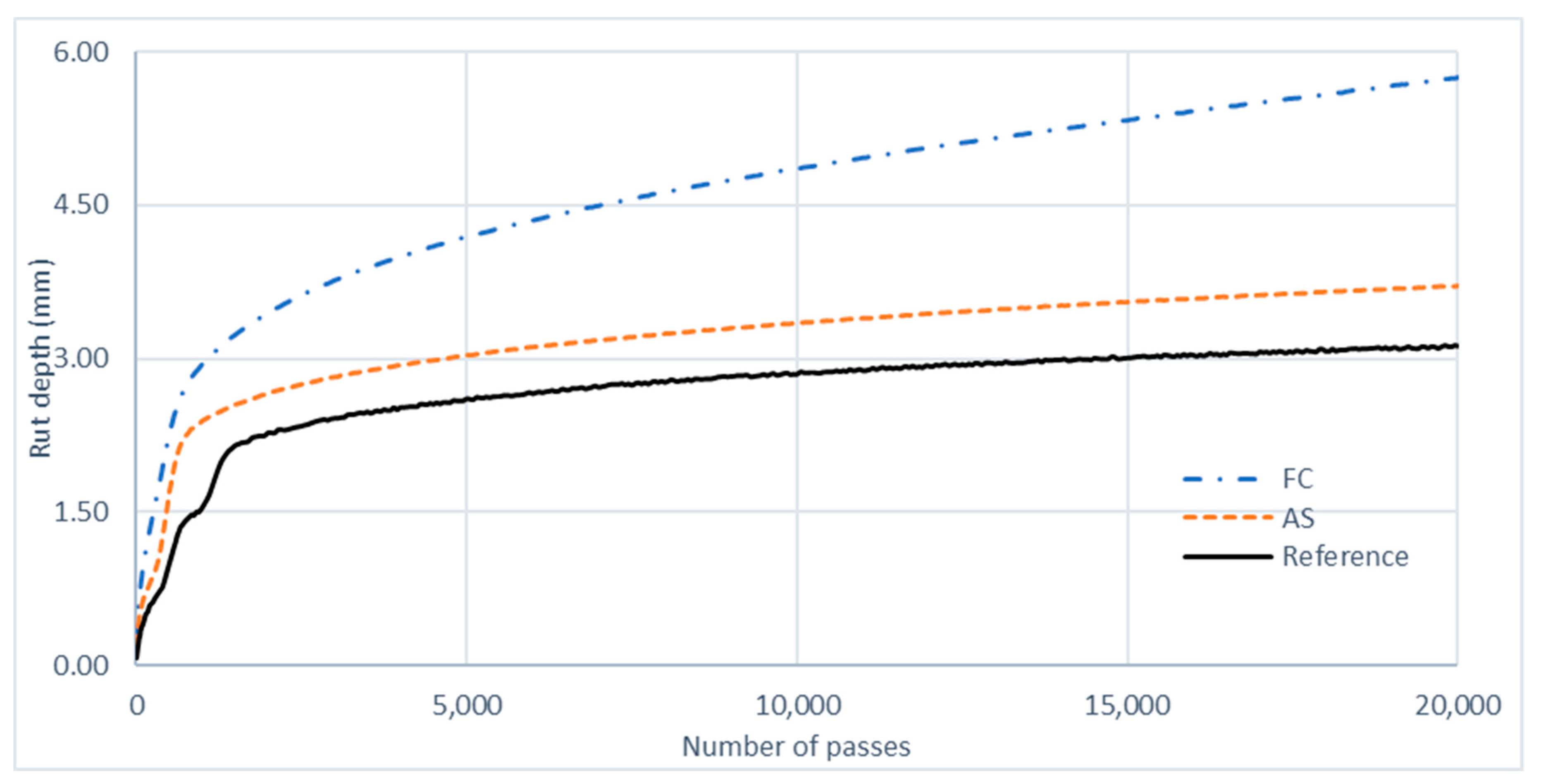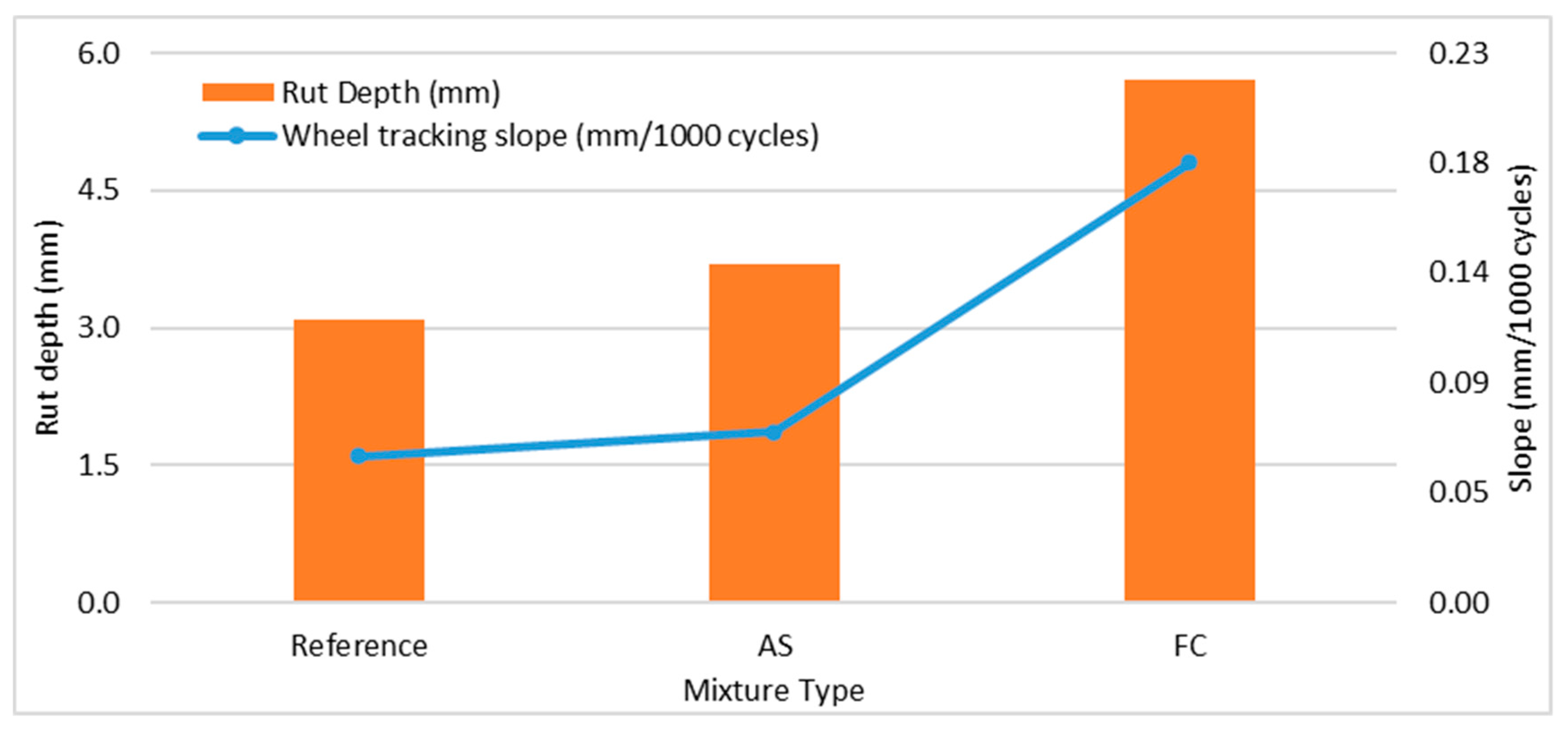Utilisation of Waste Sludge from Drinking Water Treatment as a Filler Material in Hot Mix Asphalt
Abstract
1. Introduction
2. Materials
2.1. Bitumen
2.2. Aggregate
2.3. Mixture
2.4. Drinking Water Treatment Sludge (DWTS)
3. Experimental Methods
- Fillers have more surface area per unit volume, therefore increasing the amount of filler in the mixture will require more bitumen in the mixture, thus increasing the cost of HMA with added DWTS.
- HMA tends to have rutting potential because of the excessive void.
- Increased DWTS causes decreased TSR.
- The Marshall stability for a 3% DWTS mixture is greater than for the other DWTS amounts.
4. Evaluation
5. Conclusions
Author Contributions
Funding
Institutional Review Board Statement
Informed Consent Statement
Data Availability Statement
Acknowledgments
Conflicts of Interest
References
- SUEN Turkish State Water Affairs Institution in the National Water Plan 2019–2023; Turkish Water Institute: Istanbul, Turkey, 2018.
- TURKSTAT Turkish Statistical Institute. Municipal Water Indicators, Water and Wastewater Statistics; TURKSTAT: Ankara, Turkey, 2020.
- ISKI Istanbul Metropolitan City. Activity Report. (I 1); ISKI Istanbul Metropolitan City: Istanbul, Turkey, 2018.
- ISKI Istanbul Metropolitan City. Activity Report. (I 2); ISKI Istanbul Metropolitan City: Istanbul, Turkey, 2019.
- ISKI Istanbul Metropolitan City. Activity Report. (I 3); ISKI Istanbul Metropolitan City: Istanbul, Turkey, 2020.
- ISKI Istanbul Metropolitan City. Activity Report. (I 4); ISKI Istanbul Metropolitan City: Istanbul, Turkey, 2021.
- ISKI Istanbul Metropolitan City. Activity Report. (I 5); ISKI Istanbul Metropolitan City: Istanbul, Turkey, 2022.
- Anastasiya, Y.; Larisa, A.S.; Sergey, O. Infrared Spectral Classification of Natural Bitumens for Their Rheological and Thermophysical Characterization. Molecules 2023, 28, 2065. [Google Scholar] [CrossRef]
- Kazem, J.; Morteza, E.; Mehdi, K.; Mehdi, K.; Moses, K. A Review of Different Aspects of Applying Asphalt Bituminous Mixes under a Railway Track. Materials 2020, 14, 169. [Google Scholar] [CrossRef]
- Abbas, S.; Piergiorgio, T.; Giulia, T.; Cesare, S. Waste Silt as Filler in Hot Mix Asphalt: A Laboratory Characterization. Appl. Sci. 2023, 13, 3473. [Google Scholar] [CrossRef]
- Tareq, R.; Abbas, M.; Filippo, G. Recycling of Waste Materials for Asphalt Concrete. Materials 2020, 13, 1495. [Google Scholar] [CrossRef] [PubMed]
- Raffaella, F.; Laura, M.; Nicola, F.; Antonio, D. Behavior Evaluation of Bituminous Mixtures Reinforced with Nano-Sized Additives: A Review. Sustainability 2020, 12, 8044. [Google Scholar] [CrossRef]
- Anastasiya, Y.; Sergey, I. Bitumen improvement with bio-oil and natural or organomodified montmorillonite: Structure, rheology, and adhesion of composite asphalt binders. Constr. Build. Mater. 2023, 364, 129919. [Google Scholar]
- Fengchi, X.; Yao, Z.; Kangjian, L. Using Waste Plastics as Asphalt Modifier: A Review. Materials 2022, 15, 110. [Google Scholar]
- Balkaya, M. The Beneficial Use of Water Treatment Sludges in Geotechnical Engineering. Ulus. Çevre Bilim. Araştırma Derg. 2019, 2, 11–19. [Google Scholar]
- Boscov, M.E.G.; Tsugawa, J.K.; Montalvan, E.L.T. Beneficial Use of Water Treatment Sludge in Geotechnical Applications as a Sustainable Alternative to Preserve Natural Soils. Sustainability 2021, 13, 9848. [Google Scholar] [CrossRef]
- Sabo, A.; Garba, T.; Bello, I.D.; Mohammed, G.U. Potentials of Sludge from Drinking Water Treatment Plant for Use as Source of Soil Nutrients for Reclamation of Degraded Land. Civ. Environ. Res. 2014, 6, 47–54. [Google Scholar]
- Verlicci, P.; Masotti, L. Reuse of Drinking Water Treatments Plants Sludge in Agriculture: Problems, Perspectives and Limitations; Department of Engineering, University of Ferrara: Ferrara, Italy, 2000. [Google Scholar]
- Stojmenović, M.; Gulicovski, J.; Nišić, N.; Ristić, N.; Liu, S.; Loredo, J.; Kragović, M. Sustainable Application of Waste Sludges from the Wastewater Treatment Plant Generated during the Production of Heating Devices in the Construction Industry. Materials 2024, 17, 1089. [Google Scholar] [CrossRef]
- Zhao, Y.; Nzihou, A.; Ren, B.; Lyczko, N.; Shen, C.; Kang, C.; Ji, B. Waterworks Sludge: An Underrated Material for Beneficial Reuse in Water and Environmental Engineering. Waste Biomass Valorization 2021, 12, 4239–4251. [Google Scholar] [CrossRef]
- Kevin, B.G.; Pachecoa, E.; Guzmánb, A.; Pereirac, Y.A.; Cuadrod, H.C.; Vlenciae, J.A.F. Use of Sludge Ash From Drinking Water Treatment Plant in Hydraulic Mortars. Mater. Today Commun. 2020, 23, 100930. [Google Scholar]
- Liu, Y.; Zhuge, Y.; Chow, C.; Keegan, A.; Li, D.; Pham, P.N.; Huang, J.; Siddique, R. Utilization of Drinking Water Treatment Sludge in Concrete Paving Blocks: Microstructural Analysis, Durability and Leaching Properties. J. Environ. Manag. 2020, 262, 110352. [Google Scholar] [CrossRef]
- ASTM C618-17A; Standard Specification for Coal Fly Ash and Raw or Calcined Natural Pozzolan for Use in Concrete. American Society for Testing and Materials: Washington, DC, USA, 2019.
- Noruzman, A.; Palil, N.; Ahmad, R.; Baharudin, K. Application of Waste Treatment Sludge from Water Treatment in Brick Production. Int. J. Technol. Innov. Humanit. 2020, 1, 32–40. [Google Scholar] [CrossRef]
- Caniani, D.; Masi, S.; Mancini, I.M. Innovative Reuse of Drinking Water Sludge in Geo-environmental Applications. Waste Manag. 2013, 33, 1461–1468. [Google Scholar] [CrossRef]
- Liu, Y.; Zhuge, Y. Turning on Drinking Water Treatment Sludge into Eco-Friendly Concrete; University of South Australia: Adelaide, SA, Australia, 2019. [Google Scholar]
- Kizinievič, O.; Kizinievič, V. Utilization of Drinking Water Treatment Sludge for the Manufacturing of Ceramic Products. In IOP Conference Series: Materials Science and Engineering; IOP Publishing: Bristol, UK, 2017; Volume 251. [Google Scholar]
- Sarabia-Guarín, A.; Sánchez-Molina, J.; Bermúdez-Carrillo, J.C. Effect of Use Residual Sludge from Water Treatment Plants as a Partial Substitute for Clay for Refractory Bricks Production. In Revista UIS Ingenierías; Universidad Industrial de Santander: Bucaramanga, Colombia, 2021; Volume 20, Number 1; pp. 11–22. [Google Scholar]
- Zandi, Y.; Ozturk, N.; Ozturk, H.T.; Durmus, A. Study of Utilization in Cement of Activated Drinking Water Treatment Sludge at Various Temperatures. Adv. Environ. Biol. 2012, 6, 2958–2965. [Google Scholar]
- Sofy, A.S.; Faried, A.S.; Sofi, W.H.; Abd El-Aziz, M.A. Influence of Reuse of Drinking Water Treatment Plants Sludge in Concrete. Int. J. Eng. Res. Technol. (IJERT) 2023, 12, 367–377. [Google Scholar]
- Rodrigues, C.B.; Carneiro, A.M.P. Influence of Calcination and Comminution of Drinking Water Treatment Sludge on the Properties of Ceramics. Preprints 2023, 2023030356. [Google Scholar]
- Nuria, O.; Carmen, H.; Maria, P.; Miguel, A.; Adrían, M.; Miguel, M. 2020, Using Dewatered Sludge from a Drinking Water Treatment Plant for Phosphorus Removal in Constructed Wetlands. WIT Trans. Ecol. Environ. 2022, 242, 111–119. [Google Scholar]
- El-Eneina, A.; Shebla, A.; El-Dahab, A. Drinking Water Treatment Sludge as an Efficient Adsorbent for Heavy Metals Removal. Appl. Clay Sci. Egypt 2017, 146, 343–349. [Google Scholar] [CrossRef]
- Zhao, Y. Development of an Alum Sludge Based Constructed Wetland System for Improving Organic Matter and Nutrients Removal in High Strength Wastewater. Environ. Prot. Agency 2010, 77. [Google Scholar]
- Kucukcongar, S.; Alakay, F. Usage of Drinking Water Treatment Plant Sludge as a Coagulant in Wastewater Treatment; Konya Teknik Üniversitesi: Konya, Turkey, 2022. [Google Scholar]
- KGM General Directorate of Highways of Turkey 2013 (KTS 2013); Technical Specification of Highways; General Directorate of Highways of Turkey: Ankara, Turkey, 2013.
- ASTM D5; Standard Test Method for Penetration of Bituminous Materials. American Society for Testing and Materials: Washington, DC, USA, 2020.
- ASTM D70; Standard Test Method for Specific Gravity and Density of Semi-Solid Asphalt Binder. American Society for Testing and Materials: Washington, DC, USA, 2021.
- ASTM D36; Standard Test Method for Softening Point of Bitumen (Ring-and-Ball Apparatus). American Society for Testing and Materials: Washington, DC, USA, 2020.
- ASTM D92; Standard Test Method for Flash and Fire Points by Cleveland Open Cup Tester. American Society for Testing and Materials: Washington, DC, USA, 2018.
- ASTM D2042; Standard Test Method for Solubility of Asphalt Materials in Trichloroethylene or Toluene. American Society for Testing and Materials: Washington, DC, USA, 2022.
- ASTM C131; Standard Test Method for Resistance to Degradation of Small-Size Coarse Aggregate by Abrasion and Impact in the Los Angeles Machine. American Society for Testing and Materials: Washington, DC, USA, 2020.
- BS 812 (part 105); Testing Aggregates. Methods for Determination of Particle Shape—Flakiness Index. British Standard: London, UK, 1985.
- TS EN 1097-6; Tests for Mechanical and Physical Properties of Aggregates-Part 6: Determination of Particle Density and Water Absorption. Türk Standartları Enstitüsü: Ankara, Türkiye, 2013.
- ASTM D1664; Test Method for Coating and Stripping of Bitumen-Aggregate Mixtures (Withdrawn 1992). American Society for Testing and Materials: Washington, DC, USA, 2021.
- ASTM C142; Standard Test Method for Clay Lumps and Friable Particles in Aggregates. American Society for Testing and Materials: Washington, DC, USA, 2023.
- ASTM D1559; Test Method for Resistance of Plastic Flow of Bituminous Mixtures Using Marshall Apparatus (Withdrawn 1998). American Society for Testing and Materials: Washington, DC, USA, 2021.
- AASHTOT324-11; Standard Method of Test for Hamburg Wheel-Track Testing of Compacted Hot Mix Asphalt (HMA). American Association of State Highway and Transportation Officials: Washington, DC, USA, 2011.
- AASHTO T 283; Standard Method of Test for Resistance of Compacted Asphalt Mixtures to Moisture-Induced Damage. American Association of State Highway and Transportation Officials: Washington, DC, USA, 2014.







| Indicator | 2018 | 2020 |
|---|---|---|
| Total Number of Municipalities | 1399 | 1389 |
| Total amount of water drawn by drinking and potable water network (million m3) | 6193 | 6492 |
| Amount of water treated in drinking and potable water treatment plants (million m3) | 3574 | 3900 |
| Average amount of water withdrawn per person (liter/person-day) | 224 | 228 |
| Year | Amount of Water Treated (Million m3) | Amount of Sludge Produced (kg) | The Amount of Water Treated to Obtain 1 kg of Sludge (kg) |
|---|---|---|---|
| 2018 | 1,040,965 | 89,226,113 | 11.67 |
| 2019 | 1,061,770 | 102,507,300 | 10.36 |
| 2020 | 1,074,134 | 132,538,070 | 8.10 |
| 2021 | 1,073,990 | 128,507,880 | 8.36 |
| 2022 | 1,103,672 | 121,588,820 | 9.08 |
| Name of Plant | Sludge (kg/Year) | Average Solid Matter Ratio (%) | ||||
|---|---|---|---|---|---|---|
| 2018 | 2019 | 2020 | 2018 | 2019 | 2020 | |
| Buyukcekmece | 6,012,573 | 5,300,000 | 6,500,330 | 17.91 | 17.58 | Unspecified |
| Kagithane | 19,154,420 | 16,841,030 | 11,864,190 | 18.62 | 19.31 | Unspecified |
| Ikitelli | 20,349,190 | 24,043,270 | 23,335,120 | 19.01 | 18.20 | Unspecified |
| Tasoluk | 620,700 | 671,000 | 754,280 | 18.68 | 18.23 | Unspecified |
| Omerli | 4,710,610 | 18,173,400 | 25,439,050 | 30.00 | 30.00 | Unspecified |
| Cumhuriyet | 38,378,620 | 37,478,600 | 64,645,100 | 36.01 | 35.13 | Unspecified |
| Total | 89,226,113 | 102,507,300 | 132,538,070 | 27.06 | 26.30 | Unspecified |
| Test | Test Method | Unit | Test Result | Specification Limits |
|---|---|---|---|---|
| Penetration | ASTM D-5 [37] | 0.1 mm | 53 | 50–70 |
| Specific Gravity d25/25 | ASTM D-70 [38] | gr/cm3 | 1.028 | |
| Softening point | ASTM D-36 [39] | °C | 48.6 | 46–54 |
| Cleveland Flash Point | ASTM D-92 [40] | °C | 292 | ≥230 |
| Solubility | ASTM D-2042 [41] | % | 100 | ≥99.0 |
| Sieve Size | Specification Limits (Passing %) | Aggregate Gradation (Passing %) | Gradation of FC (%) | ||||
|---|---|---|---|---|---|---|---|
| (Inch) | (mm) | 19–37.5 mm | 12–19 mm | 5–12 mm | Mixture | ||
| ¾″ | 19 | 100 | 100 | 100 | 100 | 100 | |
| ½″ | 12.5 | 88–100 | 18 | 99 | 100 | 92.1 | |
| 3/8″ | 9.5 | 72–90 | 1 | 84 | 98 | 82.4 | |
| No 4 | 4.75 | 42–52 | 1 | 16 | 98 | 49.7 | 100.0 |
| No 10 | 2.00 | 25–35 | 1 | 5 | 61 | 28.8 | 98.1 |
| No 40 | 0.425 | 10–20 | 1 | 3 | 24 | 11.9 | 54.2 |
| No 80 | 0.180 | 7–14 | 1 | 3 | 17 | 8.7 | 39.9 |
| No 200 | 0.075 | 3–8 | 1 | 2 | 13 | 6.8 | 26.2 |
| Test Name | Test Method | Unit | Test Result |
|---|---|---|---|
| L.A. abrasion | ASTM C-131 [42] | % | 16 |
| Flatness index (for 5–12 mm aggregate) (Sample weight 2411.8 g) | BS 182 (part 105) [43] | % | 16 |
| Flatness index (for 12–19 mm aggregate) (Sample weight 3848.5 g) | BS 182 (part 105) [43] | % | 11 |
| Specific gravity—dry | TS EN 1097-6 [44] | g/cm3 | 2.72 |
| Water absorption in coarse aggregates | TS EN 1097-6 [44] | % | 0.44 |
| Stripping resistance | ASTM D-1664 [45] | % | 70 |
| Clay lumps and friable aggregates | ASTM C-142 [46] | % | 0 |
| Saturated dry aggregate density (4–31.5 mm aggregate) | TS EN 1097-6 [44] | g/cm3 | 2.73 |
| Properties | Result | Specification Limits |
|---|---|---|
| Bitumen content, (%) by weight | 4.6 ± 0.2 | 4.0–7.0 |
| Practical specific gravity, g/cm3 | 2.438 | |
| Marshall stability, kg | 1300 | Min 900 |
| Flow, mm | 3.1 | 2–4 |
| Void, % | 4.0 | 3–5 |
| Void filled with asphalt (bitumen), % | 70.0 | 65–75 |
| Void in mineral aggregates (VMA), % | 14.0 | 14–16 |
| Parameters | AS Sludge | FC Sludge |
|---|---|---|
| Aluminium (% dry weight) | 29.7 ± 13.3 | 10.0 ± 4.8 |
| Ferric (% dry weight) | 10.2 ± 12 | 26.0 ± 15.5 |
| Calcium (% dry weight) | 2.9 ± 1.7 | 8.32 ± 9.5 |
| Magnesium (% dry weight) | 0.89 ± 0.8 | 1.6 |
| SiO2 (% dry weight) | 33.4 ± 26.2 | N/A |
| Zinc (mg/kg) | 33.9 ± 28 | 18.7 ± 16 |
| Lead (mg/kg) | 44.1 ± 38.2 | 19.3 ± 25.3 |
| Cadmium (mg/kg) | 0.5 | 0.48 ± 0.26 |
| Nickel (mg/kg) | 44.3 ± 38.4 | 42.9 ± 39.2 |
| Copper (mg/kg) | 33.72 ± 32.5 | 18.7 ± 25.8 |
| Chromium (mg/kg) | 25.0 ± 20.1 | 25.7 ± 21.6 |
| Cobalt (mg/kg) | 1.06 | 1.61 ± 1.1 |
| p (% dry weight) | 0.35 | 0.36 |
| Total solids (mg/L) | (2500–52,345) | (2132–5074) |
| pH | 7.0 ± 1.4 | 8.0 ± 1.6 |
| BOI5 (mg/L) | 45 (2–104) | N/A |
| Amount of DWTS (FC) | Mix Density (g/cm3) | Void (%) | Void Filled with Asphalt (%) | Flow (mm) | Stability (kg) | Tensile Strength Ratio (TSR) (%) | Amount of Filler in Mixture (%) |
|---|---|---|---|---|---|---|---|
| Reference | 2.428 | 4.00 | 69.00 | 3.10 | 1300 | 56.70 | 6.8 |
| [1] | 2.400 | 5.11 | 64.09 | 3.17 | 1384 | 37.10 | 6.9 |
| [3] | 2.380 | 6.33 | 60.04 | 2.66 | 1487 | 34.60 | 7.2 |
| [5] | 2.350 | 7.11 | 55.89 | 2.30 | 1772 | 32.17 | 7.4 |
| Parameters | Mixture Type | ||
|---|---|---|---|
| Reference | FC | AS | |
| Optimum bitumen content (%) | 4.6 | 5.7 | 6.3 |
| Mix density (g/cm3) | 2.418 | 2.401 | 2.381 |
| Void (%) | 4.69 | 3.89 | 3.95 |
| Void in mineral aggregate (%) | 14.35 | 15.82 | 17.02 |
| Void filled with asphalt (%) | 67.32 | 75.39 | 76.76 |
| Marshall stability (kN) | 12.82 | 15.73 | 14.71 |
| Flow (mm) | 3.54 | 3.64 | 3.46 |
| HMA Type | Properties | Unconditioned Samples | Conditioned Samples | ||||
|---|---|---|---|---|---|---|---|
| 1 | 2 | 3 | 1 | 2 | 3 | ||
| Reference | Void (%) | 7.671 | 7.606 | 7.579 | 7.652 | 7.611 | 7.289 |
| Water absorption (%) | 70.225 | 70.017 | 70.181 | ||||
| ITS (kN) | 166.09 | 162.74 | 147.64 | 98.59 | 80.76 | 90.97 | |
| Average ITS (kN) | 158.82 | 90.11 | |||||
| TSR (%) | 56.73 | ||||||
| AS | Void (%) | 7.138 | 7.007 | 6.932 | 7.040 | 7.076 | 6.751 |
| Water absorption (%) | 70.218 | 70.142 | 70.464 | ||||
| ITS (kN) | 174.47 | 173.50 | 172.77 | 120.67 | 119.97 | 121.83 | |
| Average ITS (kN) | 173.58 | 120.83 | |||||
| TSR (%) | 69.61 | ||||||
| FC | Void (%) | 6.658 | 6.704 | 6.808 | 7.005 | 6.777 | 6.854 |
| Water absorption (%) | 71.138 | 71.454 | 71.009 | ||||
| ITS (kN) | 169.23 | 164.97 | 178.11 | 113.62 | 109.09 | 106.65 | |
| Average ITS (kN) | 170.77 | 109.79 | |||||
| TSR (%) | 64.29 | ||||||
| HMA Type | Wheel-Tracking Slope (mm/1000 Cycles) | Rut Depth (mm) |
|---|---|---|
| Reference | 0.06 | 3.1 |
| FC | 0.18 | 5.7 |
| AS | 0.07 | 3.7 |
| Mixture Type | Marshall Stability (kN) | ITS (kN) | ||
|---|---|---|---|---|
| Unconditioned | Conditioned | TSR (%) | ||
| Reference | 12.82 ± 0.39 | 158.82 ± 8.03 | 90.11 ± 7.31 | 56.73 |
| Mixture AS | 14.71 ± 0.20 | 173.58 ± 0.69 | 120.82 ± 0.76 | 69.61 |
| Mixture FC | 15.73 ± 0.73 | 170.77 ± 6.70 | 109.79 ± 3.54 | 64.29 |
Disclaimer/Publisher’s Note: The statements, opinions and data contained in all publications are solely those of the individual author(s) and contributor(s) and not of MDPI and/or the editor(s). MDPI and/or the editor(s) disclaim responsibility for any injury to people or property resulting from any ideas, methods, instructions or products referred to in the content. |
© 2024 by the authors. Licensee MDPI, Basel, Switzerland. This article is an open access article distributed under the terms and conditions of the Creative Commons Attribution (CC BY) license (https://creativecommons.org/licenses/by/4.0/).
Share and Cite
Kahveci, T.E.; Özen, H. Utilisation of Waste Sludge from Drinking Water Treatment as a Filler Material in Hot Mix Asphalt. Materials 2024, 17, 1528. https://doi.org/10.3390/ma17071528
Kahveci TE, Özen H. Utilisation of Waste Sludge from Drinking Water Treatment as a Filler Material in Hot Mix Asphalt. Materials. 2024; 17(7):1528. https://doi.org/10.3390/ma17071528
Chicago/Turabian StyleKahveci, Tuna Eyüp, and Halit Özen. 2024. "Utilisation of Waste Sludge from Drinking Water Treatment as a Filler Material in Hot Mix Asphalt" Materials 17, no. 7: 1528. https://doi.org/10.3390/ma17071528
APA StyleKahveci, T. E., & Özen, H. (2024). Utilisation of Waste Sludge from Drinking Water Treatment as a Filler Material in Hot Mix Asphalt. Materials, 17(7), 1528. https://doi.org/10.3390/ma17071528







